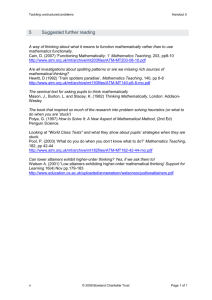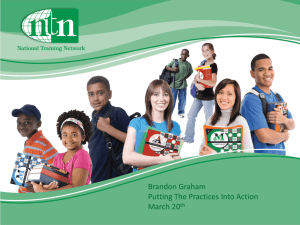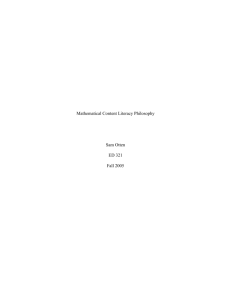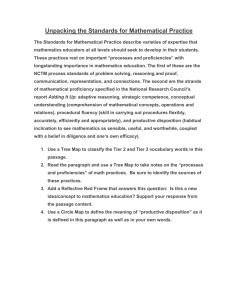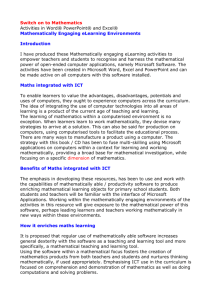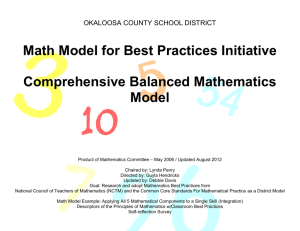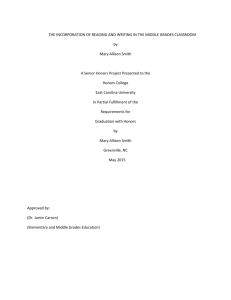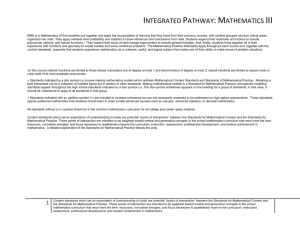Building the Language of Mathematics for Students
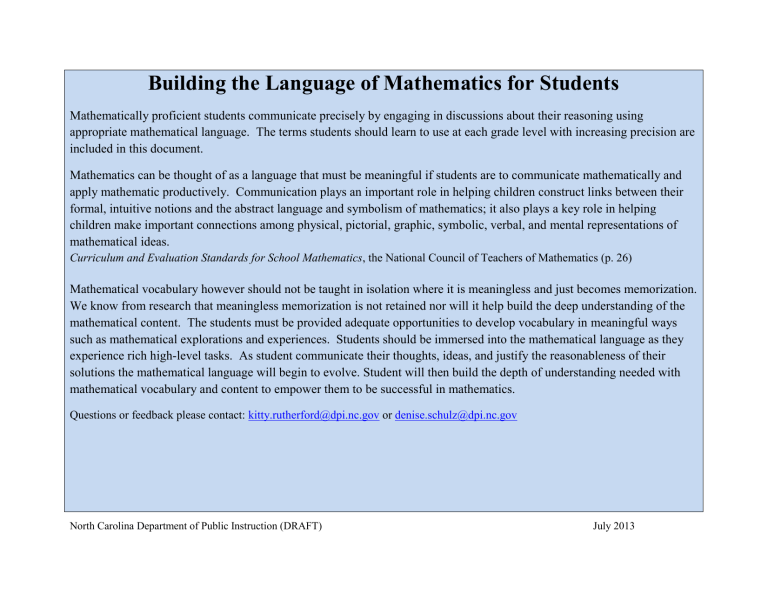
Building the Language of Mathematics for Students
Mathematically proficient students communicate precisely by engaging in discussions about their reasoning using appropriate mathematical language. The terms students should learn to use at each grade level with increasing precision are included in this document.
Mathematics can be thought of as a language that must be meaningful if students are to communicate mathematically and apply mathematic productively. Communication plays an important role in helping children construct links between their formal, intuitive notions and the abstract language and symbolism of mathematics; it also plays a key role in helping children make important connections among physical, pictorial, graphic, symbolic, verbal, and mental representations of mathematical ideas.
Curriculum and Evaluation Standards for School Mathematics , the National Council of Teachers of Mathematics (p. 26)
Mathematical vocabulary however should not be taught in isolation where it is meaningless and just becomes memorization.
We know from research that meaningless memorization is not retained nor will it help build the deep understanding of the mathematical content. The students must be provided adequate opportunities to develop vocabulary in meaningful ways such as mathematical explorations and experiences. Students should be immersed into the mathematical language as they experience rich high-level tasks. As student communicate their thoughts, ideas, and justify the reasonableness of their solutions the mathematical language will begin to evolve. Student will then build the depth of understanding needed with mathematical vocabulary and content to empower them to be successful in mathematics.
Questions or feedback please contact: kitty.rutherford@dpi.nc.gov
or denise.schulz@dpi.nc.gov
North Carolina Department of Public Instruction (DRAFT) July 2013
Counting and
Cardinality
Know number names and the count sequence.
Introduce written number words zero, one, two…ten (students are not responsible for being able to read these words, but they should be introduced)
Know digits and orally count to one hundred
Count to tell the number of objects. number, zero, one, two…thirteen, fourteen…nineteen
How many? count on
Compare numbers. greater than, more, less than, fewer equal to, same amount as, compare
Operations and
Algebraic Thinking
Understand addition as putting together and adding to, and understand subtraction as taking apart and taking from. join, putting together, add, adding to, separate, subtract, taking apart, taking from, and same amount as, equal, less than, more than, total, count on
Kindergarten
Number and
Operations in Base Ten
Work with numbers
11–19 to gain foundations for place value. ones, number, leftovers
(Know digits and recognize number words when spoken orally to twenty)
Measurement and Data
Describe and compare measurable attributes. compare, attribute, length, weight, heavy(ier), light(er), long(er), big, small(er), more of, less of, tall(er), short(er)
Classify objects and count the number of objects in categories. compare, sort, category, color words (blue, green, red, etc.), descriptive words (small, big, rough, smooth, bumpy, round, flat, etc.), more, less, same amount
Geometry
Identify and describe shapes.
Square, circles, triangle, rectangles, hexagon, cubes, cones, cylinder, sphere, flat, solid, side, corner, angle, edge, face,
Above, below, beside, in front of , behind, next to, same, different, straight lines, curved
(curvy) lines
Analyze, compare, create, and compose shapes. compare, compose, attributes, sides, vertices/corners, vertex, two-and threedimensional, same, different
North Carolina Department of Public Instruction (DRAFT) July 2013






